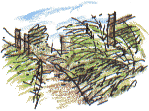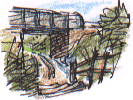Nature Diary Rocks History Gallery Home Page  BY CHANCE, I take the same path into the valley that I used to take when I first started keeping a wildlife sketchbook in the late 60s. I was an art student at a grey concrete Polytechnic overlooking the grey concrete canyon of an urban motorway in the middle of Leeds. I remember how I used to look forward to getting out of the city and back to the woodland and wetland of my valley every evening.
BY CHANCE, I take the same path into the valley that I used to take when I first started keeping a wildlife sketchbook in the late 60s. I was an art student at a grey concrete Polytechnic overlooking the grey concrete canyon of an urban motorway in the middle of Leeds. I remember how I used to look forward to getting out of the city and back to the woodland and wetland of my valley every evening.
The 'Swinging Sixties'I showed the shaky drawings of my valley sketchbook to my tutors at college.'What's that, a Dog Daisy?' asked Adrian Sparks, 'I can't tell what kind of daisy it is from your drawing. If you're serious about this why don't you do the job properly - get a camera and photograph the flowers?' I should explain that this was the end of the sixties and illustration, even drawing itself, was considered rather old fashioned. It had, to a large extent, been dropped from art college courses. In the fine art department it had all but disappeared, which was one of the reasons I opted for graphic design. But I was lucky. One of my tutors, Derek Hyatt, was, and still is, a painter with an obsession with the wilder landscapes of West Yorkshire. One day he popped down a Field Studies Council leaflet on my desk. It led to a spell on Skokholm Island, South Wales, and a chance for me to do nothing but observe and sketch wildlife every day for a fortnight. It proved to be quite a turning point for me. Thanks, Derek! Richard Bell, |
 As I may have said before, a man supporting a project to build a motorway here once described the valley as being mainly scrapyards and dereliction. But the first view you get, walking down the lane from Horbury into Addingford, is what appears to be one small wood after another stretching to the wooded ridge of Woolley Edge in the distance.
As I may have said before, a man supporting a project to build a motorway here once described the valley as being mainly scrapyards and dereliction. But the first view you get, walking down the lane from Horbury into Addingford, is what appears to be one small wood after another stretching to the wooded ridge of Woolley Edge in the distance. What really brings back memories of my summer evening rambles is the smell of Bracken on a sunny slope alongside the railway. The path then goes down a flight of stone steps, worn down by the boots of generations of miners on their way from the village to Hartley Bank Colliery.
What really brings back memories of my summer evening rambles is the smell of Bracken on a sunny slope alongside the railway. The path then goes down a flight of stone steps, worn down by the boots of generations of miners on their way from the village to Hartley Bank Colliery. The colliery stood in ruins at that time (there is no trace of it at all now) so I usually took the bridge of the old mineral railway to cross the River Calder. The railway's embankment has now been colonised by Silver Birch, but in the gaps between the trees there are still views up and down the valley over fields that sometimes flood.
The colliery stood in ruins at that time (there is no trace of it at all now) so I usually took the bridge of the old mineral railway to cross the River Calder. The railway's embankment has now been colonised by Silver Birch, but in the gaps between the trees there are still views up and down the valley over fields that sometimes flood. The rushy field was cut a month or so ago. It now looks freshly green. The three ponies turn to look at me as I walk past, along the towpath.
The rushy field was cut a month or so ago. It now looks freshly green. The three ponies turn to look at me as I walk past, along the towpath. Today's sun brings out the butterflies again; Peacock, a rather faded Meadow Brown, Comma, Large White and Wall Browns, which challenge each other alongside the old railway path.
Today's sun brings out the butterflies again; Peacock, a rather faded Meadow Brown, Comma, Large White and Wall Browns, which challenge each other alongside the old railway path.